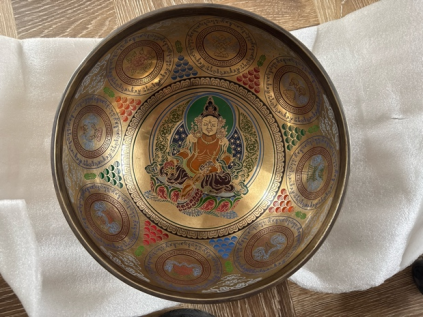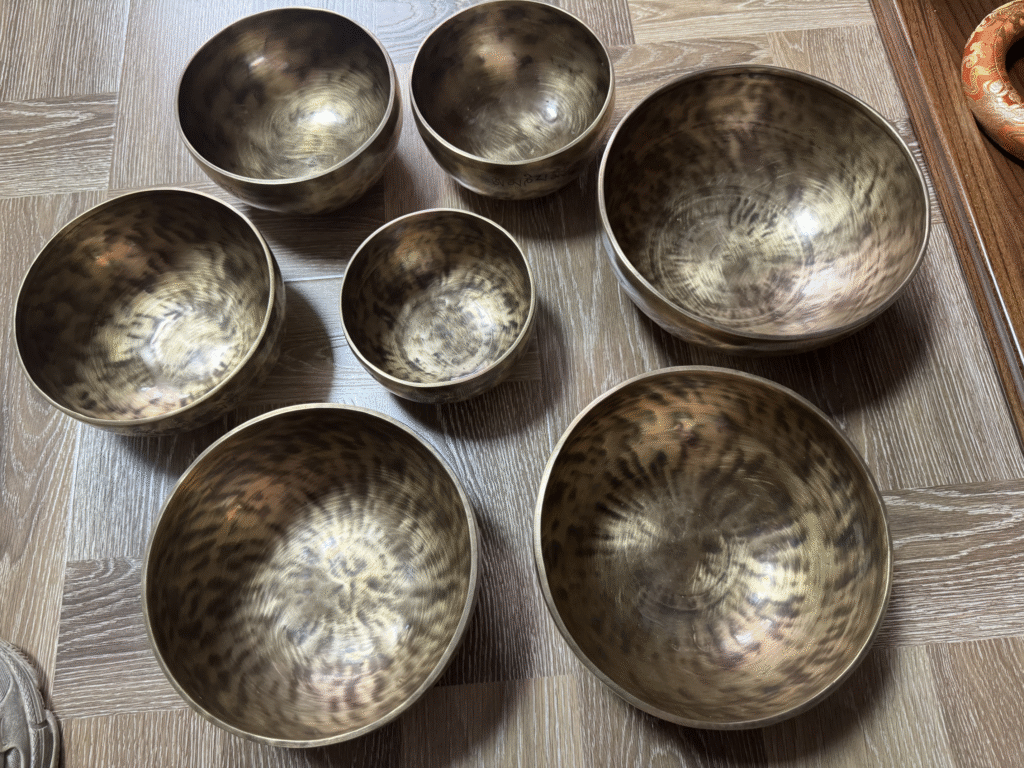The ancient art of singing bowl craftsmanship has flourished across the South Asian subcontinent for over two millennia, developing distinctive regional characteristics that reflect the profound cultural diversity, spiritual traditions, and metallurgical expertise of different communities. Among the most significant traditions are the Nepal and India styles of singing bowl creation, each representing unique approaches to instrument design, manufacturing techniques, and cultural applications that have evolved through centuries of refinement.
These two neighboring regions, despite their geographical proximity and extensive historical interaction through trade routes and cultural exchange, have maintained remarkably distinct approaches to singing bowl craftsmanship. The differences extend far beyond surface appearances to encompass fundamental aspects of metallurgy, design philosophy, manufacturing methodology, and spiritual application that create distinctly different experiences for practitioners worldwide.

Historical Background and Cultural Origins
Nepal Singing Bowl Tradition Development
The development of Nepal’s distinctive singing bowl tradition emerges from the unique cultural synthesis that characterized the Kathmandu Valley and surrounding Himalayan regions. Archaeological evidence suggests that bronze working in the Kathmandu Valley dates back over two millennia, with early Buddhist monasteries serving as centers for both spiritual practice and artisanal development.
The influence of Tibetan Buddhism proved particularly significant in shaping Nepal’s approach to singing bowl design and cultural application. Tibetan monastic communities brought sophisticated understanding of sound’s role in meditation practice, along with specific preferences for tonal relationships that supported contemplative states and spiritual development. This influence helped establish manufacturing standards and cultural practices that distinguished Nepalese instruments from other regional traditions.
Traditional workshop systems in Nepal operated as family enterprises where knowledge passed through generations of master craftsmen who carefully guarded their techniques while gradually incorporating innovations that enhanced acoustic performance and aesthetic appeal. The strategic position of Nepal along ancient trade routes connecting Tibet with the Indian plains created opportunities for cultural synthesis that enriched local traditions while maintaining distinctive regional characteristics.
India Singing Bowl Cultural Evolution
India’s singing bowl traditions reflect the subcontinent’s extraordinary cultural diversity and millennia-old spiritual practices that understood sound as a fundamental cosmic force. The ancient Vedic traditions recognized sound, particularly the sacred syllable “Om,” as the primordial vibration from which all creation emerged, creating philosophical frameworks that understood musical instruments as tools for spiritual transformation.
Regional variations within India created multiple centers of singing bowl production, each developing distinctive characteristics that reflected local cultural preferences, available materials, and religious practices. Northern regions influenced by Central Asian cultures developed preferences for geometric precision, while southern areas maintained stronger connections to ancient Dravidian artistic traditions emphasizing organic forms and symbolic ornamentation.
The diversity of religious and philosophical traditions within India created demand for instruments serving various spiritual practices, from Vedic ceremonies to Buddhist meditation and folk religious observances. This diversity encouraged technical innovation and aesthetic experimentation that enriched the overall tradition while creating multiple sub-styles serving different cultural needs.
Geographic Environment and Material Sources
Nepal’s Geographic Advantages
Nepal’s unique position in the Himalayas provides access to diverse mineral resources while creating environmental conditions that have significantly influenced traditional singing bowl craftsmanship. The Himalayan mountain ranges contain rich deposits of copper, tin, and other metals essential for traditional bronze alloys, with many mining sites located within reasonable distance of major crafting centers in the Kathmandu Valley.
High-altitude environments present unique challenges and opportunities for metalworking, with traditional craftsmen developing techniques specifically adapted to these conditions. The monsoon climate patterns create seasonal variations that affect both manufacturing processes and instrument storage, leading to traditional scheduling practices and storage methods that accommodate environmental cycles while maintaining production quality.
India’s Resource Distribution
The Indian subcontinent’s vast geographical extent and geological diversity provide access to an extraordinary range of mineral resources that have supported sophisticated metallurgical traditions for millennia. The Deccan Plateau contains extensive mineral deposits including high-quality copper and tin essential for bronze production, with traditional mining centers developing sophisticated extraction techniques.
River systems, particularly the Ganges and its tributaries, provided transportation networks that facilitated distribution of raw materials and finished products while supplying water power for workshops. Climate diversity across the subcontinent creates different environmental conditions that influence manufacturing techniques and seasonal production patterns, enabling regional specialization and complementary production cycles.
Manufacturing Technique Comparison
Nepal Traditional Craft Characteristics
Traditional Nepalese singing bowl manufacturing emphasizes hand-forging techniques that create instruments with exceptional acoustic properties and distinctive cultural characteristics. The process begins with careful preparation of bronze alloys using traditional seven-metal formulations that combine functional metallurgy with spiritual symbolism reflecting Buddhist and Hindu traditions.
Hand-forging represents the heart of Nepalese craftsmanship, where skilled artisans transform molten bronze into resonant instruments through thousands of precise hammer strikes. This process requires extraordinary sensitivity to metal response, with experienced makers adjusting their technique continuously based on acoustic feedback. The traditional hammering patterns create subtle thickness variations throughout the bowl that contribute to complex harmonic development impossible to achieve through mechanical methods.
Surface finishing involves hand-polishing techniques using natural abrasives and traditional compounds that create distinctive surface characteristics while optimizing acoustic properties. Decoration and ornamentation reflect Buddhist and Hindu artistic traditions, with hand-engraved designs serving both aesthetic and acoustic functions while carrying spiritual significance.
India Manufacturing Method Features
Indian singing bowl manufacturing demonstrates remarkable diversity reflecting the subcontinent’s varied cultural traditions and technological capabilities. Different regions have developed distinctive approaches that serve local preferences while contributing to the overall richness of Indian singing bowl traditions.
Rajasthan represents one of the most significant centers for production, where traditional metalworking communities have adapted ancient techniques to serve contemporary markets while maintaining cultural authenticity. West Bengal’s manufacturing traditions reflect the region’s history as a center for bronze working, where craftsmen have developed techniques combining traditional artistic sensibilities with practical market considerations.
Modern manufacturing innovations have been adopted selectively by Indian craftsmen seeking to improve efficiency while preserving essential traditional characteristics. Batch production methods enable serving large-scale markets while maintaining quality standards, with quality control systems often combining traditional evaluation methods with contemporary testing techniques.
Design Style and Appearance Features
Nepal Style Design Elements
Nepalese singing bowl design reflects sophisticated aesthetic sensibilities that characterize traditional Himalayan art, where functional requirements combine with spiritual symbolism to create instruments serving both practical and ceremonial purposes. Traditional bowl shapes typically emphasize smooth, flowing curves that optimize acoustic properties while reflecting aesthetic principles derived from Buddhist and Hindu artistic traditions.
Wall thickness characteristics often demonstrate subtle variations resulting from hand-forging techniques while serving acoustic optimization purposes. Traditional decorative elements may include hand-engraved mantras, Buddhist symbols, or geometric patterns that reflect spiritual significance while contributing to cultural authenticity and market value.
India Style Design Philosophy
Indian singing bowl design demonstrates extraordinary diversity characterizing artistic traditions across the subcontinent. Northern Indian design traditions often emphasize geometric precision and decorative sophistication reflecting Mughal influences, while southern approaches may reflect stronger connections to ancient Dravidian traditions emphasizing organic forms and symbolic ornamentation.
Contemporary design innovations demonstrate how traditional Indian craftsmen adapt historical knowledge to serve modern market requirements while preserving essential cultural characteristics. Functional design considerations often reflect practical requirements for different applications including temple use, personal meditation, and therapeutic practice.
Acoustic Properties and Sound Quality Analysis
Nepal Singing Bowl Sound Characteristics
Nepalese singing bowls demonstrate distinctive acoustic characteristics that reflect sophisticated understanding of sound physics and harmonic relationships developed through generations of refinement. The instruments typically produce rich, complex tones with extended sustain duration and elaborate harmonic development that support both musical and therapeutic applications.
Fundamental frequency characteristics often emphasize warm, grounding tones with strong low-frequency content that provides foundation for complex harmonic structures. The careful control of wall thickness and bowl geometry creates optimal conditions for fundamental tone production while enabling sophisticated overtone development.

Tonal System Characteristics (CDEFGAB)
The Nepal style approach to tonal organization following the C-D-E-F-G-A-B sequence represents sophisticated integration of Western musical concepts with traditional Buddhist and Himalayan spiritual practices. This sequential organization creates intuitive melodic relationships that facilitate learning and musical development while maintaining compatibility with international musical standards.
The C-D-E-F-G-A-B sequence provides several distinct acoustic advantages. The sequential arrangement creates predictable interval relationships that enable users to develop melodic phrases and harmonic combinations following familiar musical patterns. From a scientific acoustics perspective, this organization enables precise frequency relationships based on equal temperament tuning systems, facilitating integration with other musical instruments while ensuring consistent acoustic results.
Traditional chakra correspondence systems often associate this sequence with ascending energy centers within the human body, creating frameworks for therapeutic application that combine ancient wisdom with modern understanding of sound’s physiological effects.
India Singing Bowl Acoustic Performance
Indian singing bowls demonstrate acoustic characteristics that reflect deep integration with classical Indian music theory and ancient Vedic sound principles emphasizing harmonic resonance relationships over purely melodic considerations. These instruments often prioritize complex acoustic interactions and harmonic richness that create immersive sound environments.
Tonal System Characteristics (FCGDAEB)
The India style F-C-G-D-A-E-B tonal organization represents sophisticated integration with Indian classical music theory and ancient Vedic sound principles that prioritize harmonic resonance relationships. This arrangement follows the circle of fifths progression, creating optimal acoustic interactions that maximize resonance and harmonic complexity.
The F-C-G-D-A-E-B sequence follows mathematical relationships inherent in the circle of fifths, where each note maintains perfect fifth intervals with specific other notes in the arrangement. This organization creates acoustic phenomena including sympathetic resonance, harmonic beating, and combination tones that enhance therapeutic effectiveness and spiritual impact.
The arrangement enables integration with traditional Indian classical music concepts including raga structures and melodic development techniques that have been refined over millennia. Indian music theory recognizes specific frequency relationships as capable of evoking particular emotional states and spiritual responses, with this arrangement optimizing these psychological and spiritual effects.
A Reddit post explains: https://www.reddit.com/r/musictheory/comments/nredge/the_starting_of_fcgdaeb/
Acoustic Performance Comparative Assessment
The fundamental difference between sequential (C-D-E-F-G-A-B) and harmonic (F-C-G-D-A-E-B) organization creates distinctly different acoustic experiences that serve different musical, therapeutic, and spiritual applications.
Sequential frequency distribution enables melodic development following Western musical conventions, making Nepal style bowl sets particularly suitable for users with musical backgrounds or those seeking to incorporate singing bowls into contemporary musical compositions and therapeutic protocols emphasizing melodic clarity.
Harmonic frequency distribution maximizes resonance phenomena and acoustic complexity, creating rich sound environments that support deep meditative states and therapeutic applications where harmonic content takes precedence over melodic development. The F-C-G-D-A-E-B arrangement excels in applications that prioritize acoustic complexity and traditional Indian spiritual practices.
Religious and Spiritual Cultural Applications
Nepal Religious Traditional Applications
The role of singing bowls in Nepalese religious traditions reflects sophisticated understanding of sound’s spiritual significance in both Buddhist and Hindu practices throughout the Himalayan region. Buddhist monastery applications demonstrate deep integration into contemplative practices refined over centuries, where monks utilize these instruments to mark meditation periods, enhance chanting practices, and create acoustic environments supporting spiritual development.
Temple worship ceremonies often incorporate singing bowls as integral elements that enhance ritual effectiveness while creating sacred acoustic environments. Meditation practice support represents perhaps the most widespread application, where instruments create acoustic conditions that facilitate concentration and support progression through various stages of contemplative development.
India Religious Cultural Background
The integration of singing bowls into Indian religious traditions reflects the subcontinent’s ancient understanding of sound as fundamental cosmic force. Classical Hindu traditions recognize singing bowls as manifestations of cosmic sound principles that connect individual consciousness with universal harmony, while Vedic ceremony applications demonstrate ancient origins of sound-based spiritual practice.
Yoga practice integration reflects contemporary adaptations of traditional instruments to serve modern spiritual needs while maintaining connection to ancient wisdom traditions. Ayurvedic healing traditions incorporate singing bowls as therapeutic tools addressing both physical and spiritual aspects of health through acoustic intervention.
Usage Scenarios and Application Fields
Professional Sound Therapy Applications
Professional sound therapy demonstrates significant preferences between Nepal and India style singing bowls based on acoustic characteristics and therapeutic effectiveness. Many professional sound healers develop strong preferences for specific regional styles based on training background, cultural orientation, and client population characteristics.
Nepal style instruments often excel in grounding and stability work due to their sequential tonal organization and warm acoustic characteristics, while India style bowls may be preferred for complex harmonic healing and energy balancing applications that utilize their sophisticated acoustic interactions.
Personal Meditation Practice
Individual meditation practitioners often develop preferences based on personal resonance, cultural background, and meditation technique requirements. Nepal style bowls with their sequential organization often appeal to practitioners with Western musical backgrounds or those seeking structured melodic progression in their practice.
India style bowls attract practitioners drawn to complex harmonic environments and traditional Indian spiritual approaches that emphasize acoustic sophistication over melodic familiarity. Both traditions offer suitable options for various experience levels while providing growth potential for developing practitioners.
Educational and Cultural Transmission
Educational applications demonstrate how different bowl traditions serve various learning objectives including cultural awareness, meditation instruction, and therapeutic training. Nepal style instruments often prove more accessible for educational programs emphasizing practical skills and Western musical integration, while India style bowls serve programs focused on traditional knowledge systems and cultural preservation.
Craft Heritage and Innovation Development
Traditional Skill Preservation
The preservation of traditional singing bowl craftsmanship represents a crucial intersection of cultural heritage maintenance and economic development. Both Nepal and India have recognized singing bowl traditions as valuable cultural heritage requiring protection through various governmental and international programs.
Traditional apprenticeship systems continue operating alongside more formal training programs that seek to preserve essential knowledge while improving economic viability for new generations of craftsmen. Documentation efforts utilize modern recording techniques while respecting traditional knowledge protocols and community ownership rights.
Modern Innovation Development
Contemporary innovation demonstrates how traditional knowledge can inform modern development while preserving essential cultural characteristics. Technical improvements may include better tools and enhanced quality testing without compromising traditional manufacturing approaches and cultural integrity.
Design innovation trends reflect contemporary aesthetic preferences while maintaining connection to traditional cultural values and spiritual significance. Market demand adaptation involves developing products that serve contemporary needs while maintaining traditional authenticity and cultural significance.
Consumer Selection Guide
Needs Assessment and Selection
Effective singing bowl selection requires systematic evaluation of intended applications, personal preferences, cultural interests, and practical requirements. Usage purpose analysis involves honest assessment of how instruments will be utilized, while budget considerations should balance immediate affordability with quality requirements and cultural authenticity.
Nepal style instruments typically serve serious practitioners and collectors seeking cultural significance and exceptional acoustic properties, while India style bowls often provide suitable options for beginners and institutional users requiring practical performance and accessible pricing.
Purchase and Maintenance Recommendations
Successful acquisition requires careful attention to evaluation methods and source verification to ensure authentic traditional instruments while supporting legitimate traditional communities. Field inspection provides opportunities for direct instrument evaluation and personal connection, while online purchasing requires additional caution and seller verification.
Proper maintenance ensures optimal acoustic performance while preserving cultural artifacts throughout extended use periods. Daily care methods include gentle cleaning and appropriate storage, while professional maintenance services preserve instrument value and cultural authenticity.
Conclusion and Recommendations
The comprehensive analysis reveals two sophisticated cultural systems that have evolved distinct approaches while sharing common heritage and complementary strengths within the global singing bowl community. Nepal’s emphasis on traditional hand-forging creates individual character and cultural authenticity, while India’s diverse approaches serve various market segments through both traditional and modern methods.
Understanding these differences enables informed decisions that support appropriate traditional communities while providing meaningful instruments for personal practice and cultural engagement. Nepal style instruments excel in traditional spiritual practices and premium applications with their C-D-E-F-G-A-B sequential organization, while India style bowls provide reliable options for education and therapy through their F-C-G-D-A-E-B harmonic arrangement.
The future vitality of both traditions depends on maintaining cultural authenticity while adapting to contemporary realities that ensure tradition survival and continued relevance. Success requires balancing preservation requirements with development needs that support traditional communities while serving global demand for authentic cultural experiences and spiritual tools.
Both traditions offer valuable contributions through their distinct strengths and cultural characteristics. The continued preservation and development of these remarkable cultural achievements requires informed consumers, cultural education, and sustainable approaches that preserve traditional knowledge while serving contemporary needs and ensuring transmission to future generations.







